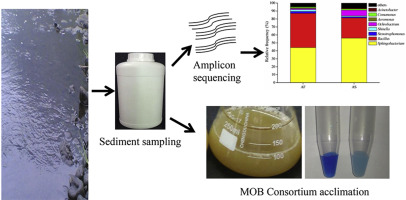当前位置:
X-MOL 学术
›
Chemosphere
›
论文详情
Our official English website, www.x-mol.net, welcomes your
feedback! (Note: you will need to create a separate account there.)
A manganese-oxidizing bacterial consortium and its biogenic Mn oxides for dye decolorization and heavy metal adsorption.
Chemosphere ( IF 8.1 ) Pub Date : 2020-04-01 , DOI: 10.1016/j.chemosphere.2020.126627 Wenjie Wan 1 , Yonghui Xing 1 , Xiuxiu Qin 1 , Xiang Li 1 , Song Liu 1 , Xuesong Luo 2 , Qiaoyun Huang 2 , Wenli Chen 1
Chemosphere ( IF 8.1 ) Pub Date : 2020-04-01 , DOI: 10.1016/j.chemosphere.2020.126627 Wenjie Wan 1 , Yonghui Xing 1 , Xiuxiu Qin 1 , Xiang Li 1 , Song Liu 1 , Xuesong Luo 2 , Qiaoyun Huang 2 , Wenli Chen 1
Affiliation

|
Manganese (Mn) contamination is a common environmental problem in the world and manganese oxidizing bacteria (MOB) play important roles in bioremediation of heavy metal and organic pollution. In this study, a novel MOB consortium AS containing core microbes of Sphingobacterium and Bacillus was acclimated from Mn-contaminated rivulet sediments. The MOB consortium AS presented good Mn(II) removal performance under 500-10,000 mg/L Mn(II), with Mn(II) removal capacities ranging from 481 to 3478 mg/L. In coexistence systems of Mn(II) and Fe(II), Ni(II), Cu(II), and Zn(II), the MOB consortium AS removed 98%, 91%, 99%, and 76% of Mn(II), respectively. Additionally, the MOB consortium AS could utilize multiple carbon sources (e.g., Chitosan, β-Cyclodextrin, and Phenanthrene) to remove Mn(II), with Mn(II) removal efficiencies ranging from 11% to 97%. Meanwhile, XRD, XPS, FTIR, SEM, and EDS analyses reflected that biogenic Mn oxides (bio-MnOx-C) contained C, O, Mn (Mn(II) and Mn(IV)) and embodied in rhodochrosite and birnessite. The bio-MnOx-C exhibited second-order kinetic reaction for removal of dye, with corresponding decolorization capacities of 22.0 mg/g for methylene blue and 23.8 mg/g for crystal violet. In addition, bio-MnOx-C showed adsorption capacities of 159.0 mg/g for Cu(II), 130.7 mg/g for Zn(II), and 123.3 mg/g for Pb(II). Overall, this study illustrates consortium AS and bio-MnOx-C have great potentials in remediation of pollution caused by heavy metals and organic pollutants.
中文翻译:

锰氧化细菌财团及其生物锰氧化物,用于染料脱色和重金属吸附。
锰(Mn)污染是世界上常见的环境问题,锰氧化细菌(MOB)在重金属的生物修复和有机污染中发挥重要作用。在这项研究中,一个新的MOB财团AS包含了Sphingobacterium和Bacillus的核心微生物,它们被Mn污染的小溪沉积物适应了。MOB财团AS在500-10,000 mg / L的Mn(II)下表现出良好的Mn(II)去除性能,Mn(II)去除容量范围为481至3478 mg / L。在Mn(II)和Fe(II),Ni(II),Cu(II)和Zn(II)共存的系统中,MOB财团AS去除了98%,91%,99%和76%的Mn( II)。另外,MOB联盟AS可以利用多种碳源(例如,壳聚糖,β-环糊精和菲)来去除Mn(II),而Mn(II)的去除效率在11%到97%之间。同时,XRD,XPS,FTIR,SEM和EDS分析表明,生物锰氧化物(bio-MnOx-C)包含C,O,Mn(Mn(II)和Mn(IV)),并以菱锰矿和水钠锰矿体现。生物MnOx-C表现出用于去除染料的二级动力学反应,相应的脱色能力对于亚甲基蓝为22.0 mg / g,对于结晶紫为23.8 mg / g。此外,生物MnOx-C对Cu(II)的吸附容量为159.0 mg / g,对Zn(II)的吸附容量为130.7 mg / g,对Pb(II)的吸附容量为123.3 mg / g。总体而言,这项研究表明,财团AS和生物MnOx-C在补救重金属和有机污染物造成的污染方面具有巨大潜力。生物MnOx-C表现出用于去除染料的二级动力学反应,相应的脱色能力对于亚甲基蓝为22.0 mg / g,对于结晶紫为23.8 mg / g。此外,生物MnOx-C对Cu(II)的吸附容量为159.0 mg / g,对Zn(II)的吸附容量为130.7 mg / g,对Pb(II)的吸附容量为123.3 mg / g。总体而言,这项研究表明,财团AS和生物MnOx-C在补救重金属和有机污染物造成的污染方面具有巨大潜力。生物MnOx-C表现出用于去除染料的二级动力学反应,相应的脱色能力对于亚甲基蓝为22.0 mg / g,对于结晶紫为23.8 mg / g。此外,生物MnOx-C对Cu(II)的吸附容量为159.0 mg / g,对Zn(II)的吸附容量为130.7 mg / g,对Pb(II)的吸附容量为123.3 mg / g。总体而言,这项研究表明,财团AS和生物MnOx-C在补救重金属和有机污染物造成的污染方面具有巨大潜力。
更新日期:2020-04-01
中文翻译:

锰氧化细菌财团及其生物锰氧化物,用于染料脱色和重金属吸附。
锰(Mn)污染是世界上常见的环境问题,锰氧化细菌(MOB)在重金属的生物修复和有机污染中发挥重要作用。在这项研究中,一个新的MOB财团AS包含了Sphingobacterium和Bacillus的核心微生物,它们被Mn污染的小溪沉积物适应了。MOB财团AS在500-10,000 mg / L的Mn(II)下表现出良好的Mn(II)去除性能,Mn(II)去除容量范围为481至3478 mg / L。在Mn(II)和Fe(II),Ni(II),Cu(II)和Zn(II)共存的系统中,MOB财团AS去除了98%,91%,99%和76%的Mn( II)。另外,MOB联盟AS可以利用多种碳源(例如,壳聚糖,β-环糊精和菲)来去除Mn(II),而Mn(II)的去除效率在11%到97%之间。同时,XRD,XPS,FTIR,SEM和EDS分析表明,生物锰氧化物(bio-MnOx-C)包含C,O,Mn(Mn(II)和Mn(IV)),并以菱锰矿和水钠锰矿体现。生物MnOx-C表现出用于去除染料的二级动力学反应,相应的脱色能力对于亚甲基蓝为22.0 mg / g,对于结晶紫为23.8 mg / g。此外,生物MnOx-C对Cu(II)的吸附容量为159.0 mg / g,对Zn(II)的吸附容量为130.7 mg / g,对Pb(II)的吸附容量为123.3 mg / g。总体而言,这项研究表明,财团AS和生物MnOx-C在补救重金属和有机污染物造成的污染方面具有巨大潜力。生物MnOx-C表现出用于去除染料的二级动力学反应,相应的脱色能力对于亚甲基蓝为22.0 mg / g,对于结晶紫为23.8 mg / g。此外,生物MnOx-C对Cu(II)的吸附容量为159.0 mg / g,对Zn(II)的吸附容量为130.7 mg / g,对Pb(II)的吸附容量为123.3 mg / g。总体而言,这项研究表明,财团AS和生物MnOx-C在补救重金属和有机污染物造成的污染方面具有巨大潜力。生物MnOx-C表现出用于去除染料的二级动力学反应,相应的脱色能力对于亚甲基蓝为22.0 mg / g,对于结晶紫为23.8 mg / g。此外,生物MnOx-C对Cu(II)的吸附容量为159.0 mg / g,对Zn(II)的吸附容量为130.7 mg / g,对Pb(II)的吸附容量为123.3 mg / g。总体而言,这项研究表明,财团AS和生物MnOx-C在补救重金属和有机污染物造成的污染方面具有巨大潜力。











































 京公网安备 11010802027423号
京公网安备 11010802027423号